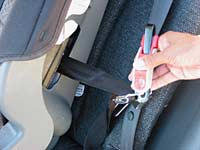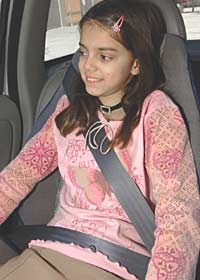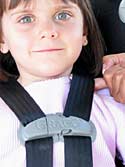Tips for Installing Child Car Seats
 Tip 1. Securing
your child car safety seat
Tip 1. Securing
your child car safety seat
Always install the seat tightly, using your body weight to tighten and
fasten the seatbelt. There should be no more than 2.5 cm (1") of movement of
the seat from side to side or forward. Each time you place your child in the
car safety seat, give it a tug to make sure it is still secure. (For securing
the seat with the Universal Anchorage System (UAS - see Tip 3).
 Tip 2. Using tether straps with forward-facing car seats
Tip 2. Using tether straps with forward-facing car seats
The tether strap for a forward-facing child car safety seat must be
used. The tether strap is located on the rear of the child car safety seat and
has a hook. The hook is designed to attach the strap to the tether anchorage on
the vehicle as specified by the vehicle manufacturer. Ensure the tether is only
secured to the designated anchorage point(s) in the vehicle as specified by the
manufacturer.
  |
Tip 3. Using Universal Anchorage System (UAS) / LATCH
All new Canadian vehicles manufactured on or after September 1, 2002
come with lower universal anchorage points. Consult the vehicle owner's manual
before using the UAS system/LATCH to determine where the anchorage points are
located and ensure that the correct method is used as advised by the car seat
manufacturer.
 Tip 4. Using locking
clips
Tip 4. Using locking
clips
Sometimes locking clips may be required to safely secure a child car
safety seat in a vehicle. Consult your owner's manual to see if you need one.
If so, install the locking clip on the seatbelt within 13 mm (1/2 inch) of the
latch plate.
 Tip 9. Installing away from
active air bags
Tip 9. Installing away from
active air bags
Always install child car safety seats away from active air bags. The
safest place is in the back seat of a passenger car, sport utility vehicle or
light truck and either the second or third row in a mini-van.
Tip 10. Installing your rear-facing child car safety seat on a proper angle
  |
Most child car safety seats have a recline position that must be used
when in the rear-facing position for an infant (up to 9kg or 20lbs). Check your
child car safety seat owner's manual for instructions. For rear-facing seats,
if necessary, use a tightly rolled towel or a foam bar (pool noodle) under the
base of the child car safety seat to adjust the angle to 45 degrees. A
forward-facing child car safety seat should be in the upright position. Make
sure that when the seat is turned from rear-facing to forward-facing, the
recline feature is adjusted to the upright position.
 Tip 11. Booster seats
Tip 11. Booster seats
Booster seats are required for children under the age of eight, weighing more than 18 kg but less than 36 kg (40-80 lbs) and who stand less than 145 cm (4 feet 9 inches) tall.
Booster seats raise a child up so that the adult seatbelt works more effectively. A lap and shoulder belt combination must be used for both the high-back and low-back booster seat. If your vehicle only has lap belts in the rear seat, contact your local dealer regarding retrofitting it with a shoulder belt. Never use a lap belt alone with a booster seat designed to be used with a lap-shoulder combination belt. Your child's head must be supported by the top of the booster or vehicle seat. The shoulder strap must lie across your child's shoulder and the middle of their chest (not the neck or face) and the lap belt must cross low over the hips (not the stomach/abdomen). Never use seatbelt adjusters.
A child can start using a seatbelt alone once any one of the following criteria is met:
- the child turns eight years old;
- the child weighs 36 kg (80 lbs); or,
- the child is 145 cm (4 feet 9 inches) tall.
Tip 12. Check for the safety label
 All child car
safety seats manufactured for sale in Canada on and after March 15, 1998 must
have a Canadian Motor Vehicle Safety Standard (CMVSS) label on the seat. Prior
to this date, a Statement of Compliance label was attached to the side of the
child car safety seat. Both the CMVSS and Statement of Compliance are the
manufacturer's certification that the child car seat meets all applicable
regulations in effect at the time the child car seat was manufactured.
All child car
safety seats manufactured for sale in Canada on and after March 15, 1998 must
have a Canadian Motor Vehicle Safety Standard (CMVSS) label on the seat. Prior
to this date, a Statement of Compliance label was attached to the side of the
child car safety seat. Both the CMVSS and Statement of Compliance are the
manufacturer's certification that the child car seat meets all applicable
regulations in effect at the time the child car seat was manufactured.
Also check your child car seat for an expiry date. Some manufacturers
indicate an expiry date in the instruction booklet or on the child car safety
seat. If there is no expiry date, do not use a seat that is older than 10 years
from the date of manufacture.
If you are having difficulty or want to have your child car seat installation inspected, contact your local public health unit.
To find a public health unit, check the blue pages of your phone book, call the Ministry of Health and Long-Term Care information line at 1-800-268-1154, or visit the Ministry of Health and Long-Term Care: Public Health Units.
See also:
- Safe & Secure: Choosing the right car seat for your child
- Choose The Right Safety Seat For Your Child
- Frequently Asked Questions: Child Safety Seats and Booster Seats
Related Links*
- Transport Canada - Road Safety: Child Safety






